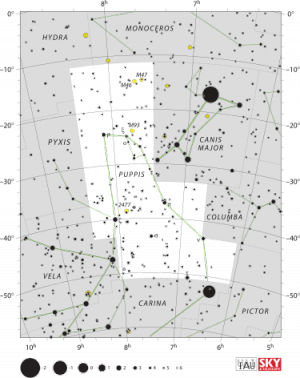Puppis
Puppis is a constellation in the southern sky. Puppis, the Poop Deck, was originally part of an over-large constellation, the ship of "Jason and the Argonauts", Argo Navis, which centuries after its initial description, was divided into three parts, the other two being Carina (the keel and hull), and Vela (the sails of the ship). Puppis is the largest of the three constellations in square degrees. It is one of the 88 modern constellations recognized by the International Astronomical Union.

Extrasolar Planets
Several extrasolar planet systems have been found around stars in the constellation Puppis, including: On July 1, 2003, a planet was found orbiting the star HD 70642. Thisplanetary system is much like Jupiter with a wide, circular orbit and a long-period.On May 17, 2006, HD 69830 (the nearest star of this constellation) was discovered to have three Neptune-mass planets, the first multi-planetary system without any Jupiter-like or Saturn-like planets. The star also hosts anasteroid belt at the region between middle planet to outer planet.On June 21, 2007, the first extrasolar planet found in the open cluster NGC 2423, was discovered around the red giant star NGC 2423-3. The planet is at least 10.6 times the mass of Jupiter and orbits at 2.1 AU distance.On September 22, 2008, two Jupiter-like planets were discovered around HD 60532. HD 60532 b has a minimum mass of 1.03 MJ and orbits at 0.759 AU and takes 201.3 days to complete the orbit. HD 60532 c has a minimum mass of 2.46 MJ and orbits at 1.58 AU and takes 604 days to complete the orbit.
Deep Sky Objects
As the Milky Way runs through Puppis, there are a large number of open clusters in the constellation.Messier 46 and Messier 47 are two open clusters in the same binocular field. M47 can be seen with the naked eye under dark skies, and its brightest stars are 6th magnitude. Messier 93 (M93) is another open cluster somewhat to the south. NGC 2451 is a very bright open cluster containing the star c Puppis and the near NGC 2477 is a good target for small telescopes. The star Pi Puppis is the main component of a bright group of stars known as Collinder 135. M46 is a circular open cluster with an overall magnitude of 6.1 at a distance of approximately 5400 light-years from Earth. The planetary nebula NGC 2438 is superimposed; it is approximately 2900 light-years from Earth. M46 is classified as a Shapley class f and a Trumpler class III 2 m cluster. This means that it is a rich cluster that appears distinct from the star field; however, it is not at its center. The cluster's stars, numbering between 50 and 100, have a moderate range in brightness.
HGS Session References
HGS Sessions - Clearing Hyperspace Phantom Matrix - 3/12/2015 [1]HGS Sessions - Clearing Tara, Gaia, Cradle of Lyra- 3/12/2015 [2]HGS Sessions - Clearing Sexual Misery, Breeder Programs - 3/31/2015 [3]
References
- ↑ HGS Session
- ↑ HGS Session
- ↑ HGS Session
Found in HGS Manual on Page 108 Found in HGS Manual on Page 115